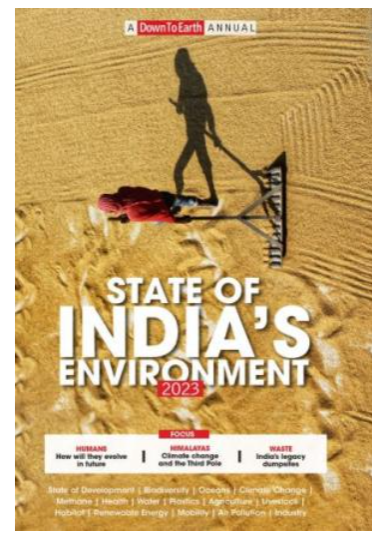The 2023 State of India’s Environment (SoE) report was officially unveiled on March 23, 2023, at India Habitat Centre (IHC), Delhi. The report covers an extensive gamut of subject assessments, ranging from climate change, agriculture and industry to water, plastics, forests and biodiversity.
The SoE Report is published every year by Down To Earth, the fortnightly magazine published by the Centre for Science and Environment (CSE). The 2023 report covers an extensive gamut of subject assessments, ranging from climate change, agriculture and industry to water, plastics, forests and biodiversity. The Annual Issue’s main focus is (i) Humans: How they will evolve in future, (ii) Himalayas: Climate change and the third pole (iii) Waste: India’s legacy deposits. Also covered in the report are topics such as plastics, livestock, state of states, state of SDGs and Covid and impacts on SDGs.

The SoE Report says that change is happening on the ground, but the scale and pace of this change needs to be far bigger. It also highlights where the nation is lagging behind.
Releasing the report, Ms Sunita Narain, Director General of SoE stated that “There is news to cheer. Environment is now mainstream – we are all outraged at how pollution is affecting our health or climate change is devastating our future. But the bad news is that we are not acting at the scale of the devastation that we see around us. We need to take more deliberate steps to reverse the damage.”
Summarising what the report also points towards, Narain said: “We must realise that this is not a time or age for war, or for divisions. We need to have a common minimum programme that brings all countries together on the only issues that matter for humanity: how to avert the existential crisis we face today and how to build a just and inclusive world order. In fact, the pandemic treaty is a welcome development in this direction,” Narain added.
Some of the darker highlights of the report include the following:
- Over 30,000 water bodies have been encroached on in the country.
- India generates 150,000 tonne of municipal solid waste every day – more than half of this is either dumped in landfills or remains unattended.
- Four years and 11 months is the average duration of life lost to air pollution in India. Rural India is losing more years due to air pollution-related health issues than the urban belt.
- In fact, rural India needs 35 per cent more community health centres
- Environmental crimes continue unabated – courts need to decide on 245 cases every day to clear the backlog.
- Between January and October 2022 (304 days), India witnessed extreme weather events on 271 days. These events claimed over 2,900 lives.
- In the past five years, India’s overall global rank in meeting the SDGs – Sustainable Development Goals – has slipped by nine places. In 2022, it stood at the 121st.
- “The Report enables us to understand the challenges, as well as explore the new approaches so that solutions for environmental management are affordable and sustainable”: Sunita Narain.
- India’s performance on the Sustainable Development Goals is a case in point – report’s analysis showcases the slippages of states, but also holds up those which are improving.
For more information, read
https://www.cseindia.org/the-state-of-india-s-environment-report-2023-11687
Source: Press Release from Centre for Science and Environment

